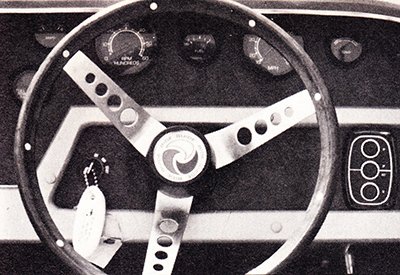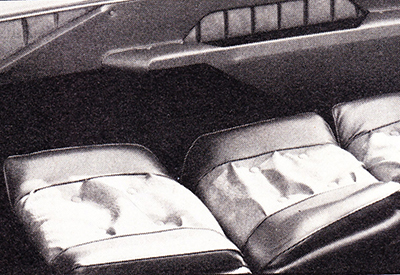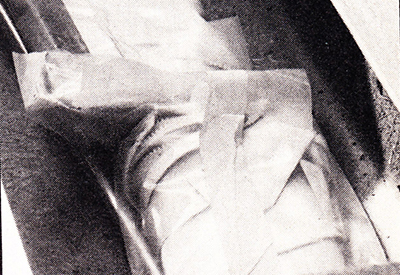Sea Ray SRV 200
By Andy Adams
Sea Ray boasts quality, longevity.
Sea Rays have been referred to in Test Bench as a yardstick against which to measure other boats. This test of a Sea Ray SRV 200 should give you some idea why.
Sea Ray goes back to 1959 and the current “Sea Ray” style originated in 1968. It’s surprising that this highly distinctive line of boats is that old. Certainly there have been many imitators, especially in recent years, but the qualities that have made Sea Ray a favourite with me are still somewhat unique to the name.
A combination of styling seaworthiness, and solid construction comes through in Sea Ray boats.
Probably no other powerboat line has had more influence on the industry. No other line is as consistently well finished, intelligently designed, and skillfully marketed year after year. There are Sea Rays in all corners of the western world.
Right on the heels of that glowing praise, let me say that the Sea Ray SRV 200 is not a favourite with me. The reason is the Mercruiser 898 stern-drive. To match the high quality and genteel nature of the Sea Ray, the power plant should be smooth, quiet and flexible. This 898 in none of those things.
Mac changed its stern-drives recently from through-hub exhaust to an open design. I understand the move was prompted by hopes of greater efficiency and therefore performance and economy, but I’m not sure it has worked. Reversing with the old through-hub exhaust sometimes brought cavitation when the exhaust was drawn back into the prop blades, and this situation has been eliminated, but the old reversing was generally quite good anyway.
 Now the engine is noticeably louder under all circumstance s and particularly under heavy throttle. Although the SRV 200 did well on fuel economy, it wasn’t exceptional, so I see no great benefit there either. At 3,000 rpm the sound-level meter registered fully 86dB, or 3 or 4 dB louder than the competition.
Now the engine is noticeably louder under all circumstance s and particularly under heavy throttle. Although the SRV 200 did well on fuel economy, it wasn’t exceptional, so I see no great benefit there either. At 3,000 rpm the sound-level meter registered fully 86dB, or 3 or 4 dB louder than the competition.
I don’t mind a throaty roar like that of a regular open exhaust, but this is noisy, mechanical clatter.
In fairness, the problem seemed more annoying in the Sea Ray than in other boats similarly equipped. I wish there were some choice here, because I really didn’t like the noise.
The test 898 had an obvious rough spot at 2,500 rpm that was very uncomfortable. Most people would be suspicious of mechanical problems if they heard it in their own boat, and that’s no plus.
The other aspect of the 898 that didn’t sit well was the throttle control. The lever scarcely moved at all to go from a slow, on-plane cruise to wide open, yet there was generous travel in other areas. It seemed that a tiny bit of movement suddenly opened the carb completely as though the linkage were set up for drag-racing.
This effect was really bad between 2,500 and 3,500 rpm because of Sea Rays ride attitude. The boat sits so far out of the water that opening up the throttle too quickly about 2,500 rpm brought the engine to life with a growl so that it cavitated and lost speed.
This power situation is out of character for Sea Ray. Performance figures themselves are quite respectable: top end of 42 mph, mechanically relaxed cruise of 28 mph at 3,000 rpm, fuel mileage of 4.28 mpg on regular gas. With the 40 gallon tank the Sea Ray makes close to 170 miles for extended cruising.
 Driving the SRV 200 is as it should be; easy, comfortable and secure. The boat has forgiving attitude; it can be run in tight and will not cavitate unless the throttle is opened more.
Driving the SRV 200 is as it should be; easy, comfortable and secure. The boat has forgiving attitude; it can be run in tight and will not cavitate unless the throttle is opened more.
Planing off, the Sea Ray comes up on plane quickly and with light throttle. This boat could handle big loads without strain. The bow never comes up high enough to strain vision, and you can plane off with the boat over on its side a bit and never fell the transition from one mode to the other.
Its 20 feet are a bit too much for a ski boat, but the Sea Ray leaves a small wake so should suit slalom-skiing. For tricking, it could do a good job but would need a heavy load to stabilize the speed since trick speeds are close to where the SRV 200 planes off. As trick wakes go, this one’s only fair, however, with a really frothy table and weak definition.
The Sea Ray’s forté is as a family boat. It will haul a mob of people and gear, ski, cruise, and go places in safety under almost any circumstances. It has generous freeboard and a deep enough V to take bad weather in comfort.
The convertible top has a neat storage boot at the stern and fits well enough, but it is the bimini design that doesn’t seem well integrated into the boat’s lines. This feature, however, never seems especially good on any boat.
The interior is very well finished, with handsome and comfortable seats. The padding should be thicker for off shore use, but the seats themselves are well-made. They recline, adjust fore and aft, and fold quite flat for sun-tanning, all on sturdy aluminum rails with big plastic knobs for release. The rear jump-seats are a generous size and good height but I’ve never been keen on riding back there: it’s too breezy. The SRV 200 has quite a long cockpit, nice for people and loads but it does bring in a fair amount of wind.
 The windshield is good, well-positioned, all of safety glass but too large to protect the whole interior. But there’s lots of room to get comfortable and the helm seat is as good as any. All controls are well-positioned and work well except for the throttle, which at least was in a good spot near an arm-rest. The gauges are hooded for glare and backlit for night use. The lockable glove-box is handy for stereo tapes and valuables.
The windshield is good, well-positioned, all of safety glass but too large to protect the whole interior. But there’s lots of room to get comfortable and the helm seat is as good as any. All controls are well-positioned and work well except for the throttle, which at least was in a good spot near an arm-rest. The gauges are hooded for glare and backlit for night use. The lockable glove-box is handy for stereo tapes and valuables.
Last year I complained about a teak drink-holder that took a bite out of my knee. Sea Ray must have been listening, because this year the helm seat drink-hold er is gone and all others are built into the storage bins under the gunwales. But, alas, in place of the drink-holders was a fire extinguisher that got me a bit further down my leg.
The fuse panel is built into the side of the helm area and has all the fuses arranged beside their corresponding switches. It is a neat system, looks great, and is very handy. I wish more boats had this feature.
There is storage under the floor for lifejackets and paddles, plus a bait well with a plug. More storage is available in the side pockets and under the dock. If Sea Ray forgot anything I couldn’t see it ; and everything is finished to a level of quality as good as any other mass-produced boat.
Sea Rays have always been priced high, but quality and longevity probably make the price a bargain in the long run.
Originally published in Canadian Yachting’s January 1979 issue.
Specifications:
Engine: Mercruiser 898. 198 hp with external exhaust.
Propeller: 15.7 x 17 inches
Length: 19 ft 7 in
Beam: 8 ft
Weight: 3,000 lbs
Photo Captions:
Photo 1 – Sea Rays higher-than-average price is backed by traditional quality and longevity.
Photo 2 – The helm seat is comfortable with well placed instrumentation.
Photo 3 – The boat seats are very comfortable, and fold flat on sturdy aluminum rails.
Photo 4 – Under-floor storage has teak cover.






















